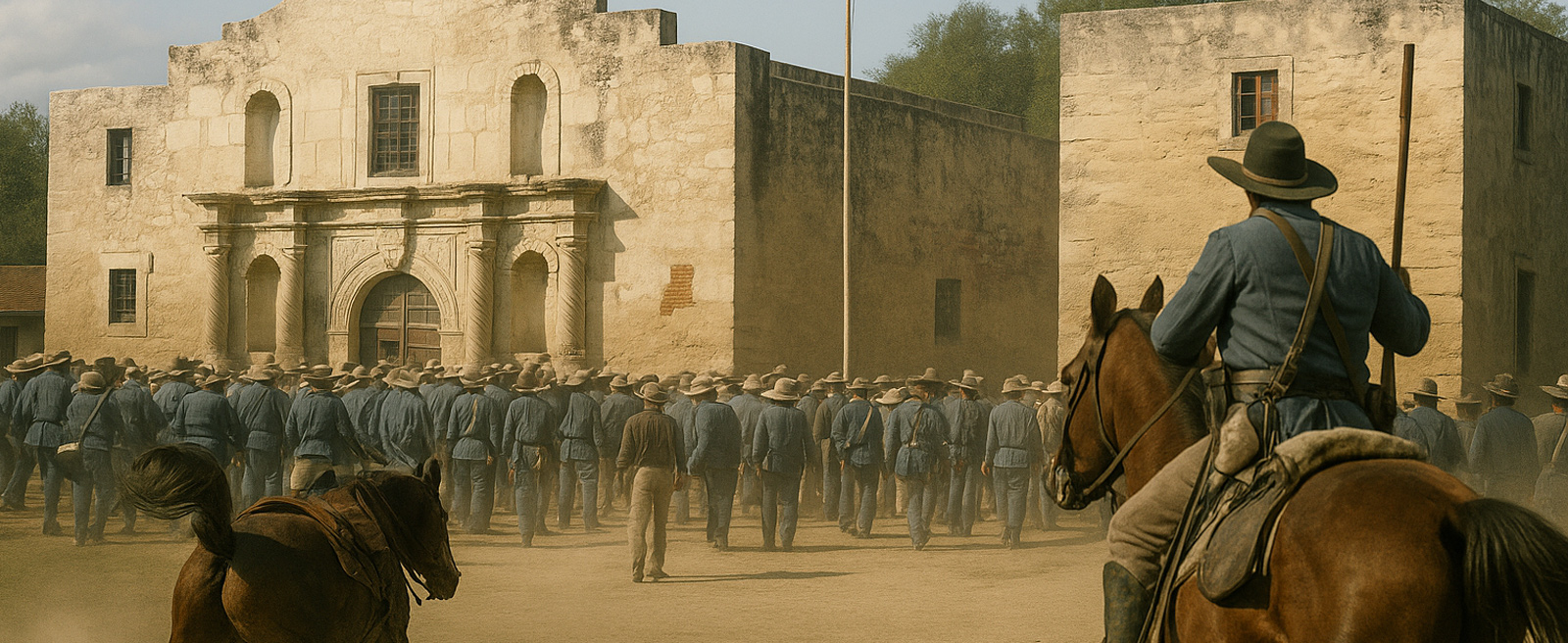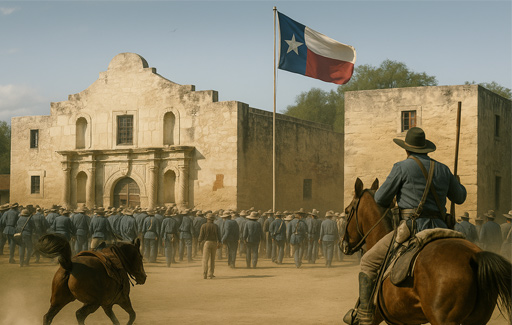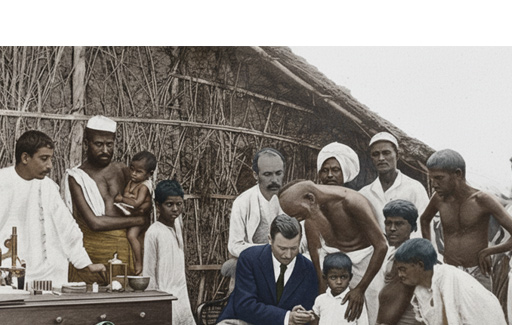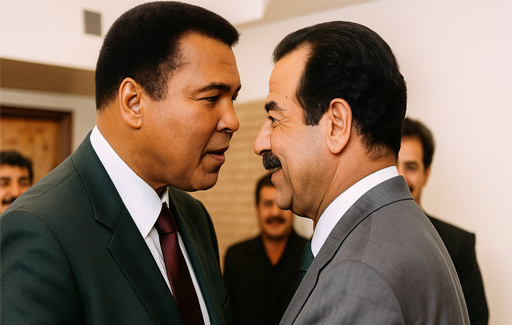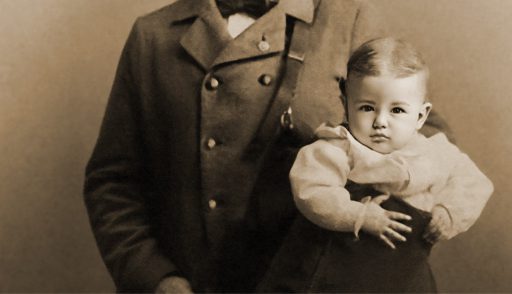Texas has one of the coolest and most exciting stories in the U.S. It used to be part of another country, got its independence, and even became its own republic for almost ten years. So how did this wild place of cowboys and cattle turn into the amazing state we know today? Let’s go back in time a bit and see how Texas broke away from Mexico and ended up joining the United States.
Texas Was Once Part of Mexico
First off, it’s key to know that Texas was originally part of Mexico. In 1821, Mexico became free from Spain, and Texas was one of its northern territories. It was a huge and mostly empty land. The Mexican government was worried about other countries, especially the U.S., trying to take it over if there weren’t enough people living there. To fix this, Mexico decided to invite settlers, especially from the U.S., to come and settle in Texas.

These American settlers, called Anglos, were given big chunks of land for really cheap. All they had to do was follow Mexican laws, convert to Catholicism, and become citizens of Mexico. A key figure in this early period was Stephen F. Austin, known as the “Father of Texas.” In 1821, he brought 300 families, known as the “Old Three Hundred,” into Texas. His friendly approach helped create trust between the settlers and the Mexican government, for a while, at least.
Growing Tensions Between Settlers and Mexico
As more American settlers moved into Texas, some problems started popping up. Most of these settlers thought and acted like Americans. They spoke English, practiced Protestant Christianity, and kept a lot of American traditions. This created tension with the Mexican government, which expected them to follow its laws, speak Spanish, and be Catholic.
Another huge issue was slavery. Many settlers came from southern states where slavery was normal, and they brought enslaved people with them to work the land. But Mexico had banned slavery in 1829, which caused a serious conflict since settlers didn’t want to let go of their slaves and resisted Mexico’s efforts to enforce anti-slavery laws in Texas.
On top of that, as more Anglo settlers arrived, they started to outnumber the Tejanos (Mexican citizens in Texas). The settlers wanted more say in the government and fewer restrictions, and many didn’t want to be ruled by officials from far-off Mexico City. As time went on, these disagreements led to deep distrust between the settlers and the Mexican government.
The Rise of Santa Anna and a Push for Independence
In the early 1830s, the Mexican government became more strict under General Antonio López de Santa Anna. He declared himself president and took full control, becoming a military dictator. He got rid of the Constitution of 1824, which had given Mexican states, including Texas, a bit of freedom and self-rule. This move upset a lot of people in Mexico, especially the Texans.

In Texas, settlers saw Santa Anna’s actions as a threat to their way of life. They thought he was taking away their rights and freedoms. Things boiled over in 1835 when Mexican troops tried to take back a cannon that settlers had been using for protection in the town of Gonzales. The settlers said no, raising a homemade flag that said “Come and Take It.” This little fight kicked off the Texas Revolution.
The Texas Revolution Begins (1835–1836)
After the Battle of Gonzales, the settlers started organizing themselves into an army and setting up a temporary government. They believed they were fighting not just to protect their homes, but also for liberty. At first, some still hoped to stay part of Mexico but with more rights. But as violence grew, more settlers began to push for full independence from Mexico.
One of the most dramatic events during the revolution happened just a few months later: the Battle of the Alamo.
The Battle of the Alamo: Heroism and Tragedy
In early 1836, about 180 to 200 Texan fighters, including famous guys like Davy Crockett, James Bowie, and William B. Travis, took refuge in an old Spanish mission called the Alamo in San Antonio. They knew Santa Anna was coming with a huge army, but they decided to stay and fight, even though they were outnumbered. For 13 days, they held off nearly 2,000 Mexican soldiers. On the final day, March 6, 1836, Santa Anna launched a brutal attack. All the defenders were killed, and Santa Anna ordered their bodies to be burned.
Even though the Texans lost this battle, the Alamo became a symbol of courage and sacrifice. “Remember the Alamo!” became the rallying cry for Texas forces for the rest of the war, inspiring more people to join the fight for freedom.
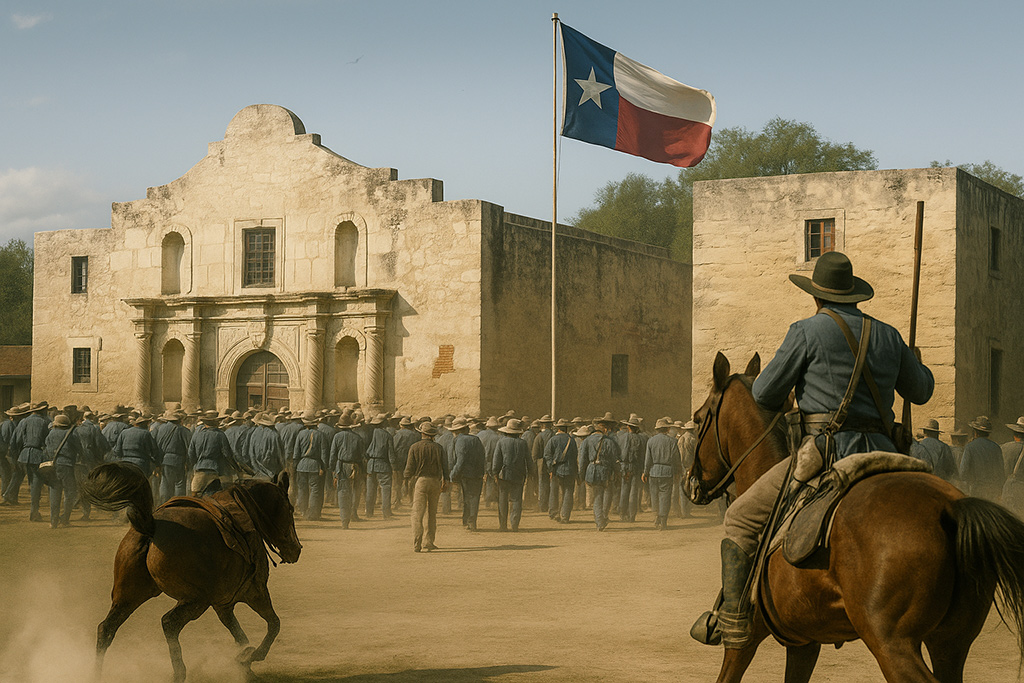
Texas Declares Independence
While the battle raged, Texas leaders got together at a convention in Washington-on-the-Brazos and made a bold move. On March 2, 1836, they declared Texas officially independent from Mexico and created the Republic of Texas.
The Texas Declaration of Independence was influenced by the U.S. Declaration of Independence. It stated the reasons why Texans believed they had the right to break away, especially pointing to Santa Anna’s harsh rule and Mexico’s failure to protect their rights. David G. Burnet was named interim president, and a temporary government was set up.
Victory at San Jacinto: Texas Wins the War
The most important battle of the Texas Revolution came just weeks later on April 21, 1836, at the Battle of San Jacinto. General Sam Houston, who had been training a Texan army, launched a surprise attack on Santa Anna’s forces near what is today Houston.
The battle lasted just 18 minutes, catching the Mexican army completely off guard. Over 600 Mexican soldiers were killed, and Santa Anna was captured the next day while trying to escape in disguise. He was brought before Sam Houston and agreed to sign a peace treaty, effectively ending the war and giving Texas its independence.
The Republic of Texas: A Nation of Its Own (1836–1845)
After the revolution, Texas was free but had to figure out how to govern itself. From 1836 to 1845, Texas was an independent country known as the Republic of Texas. It had its own constitution, army, navy, president, money, and flag. Sam Houston was the first president of this new republic.
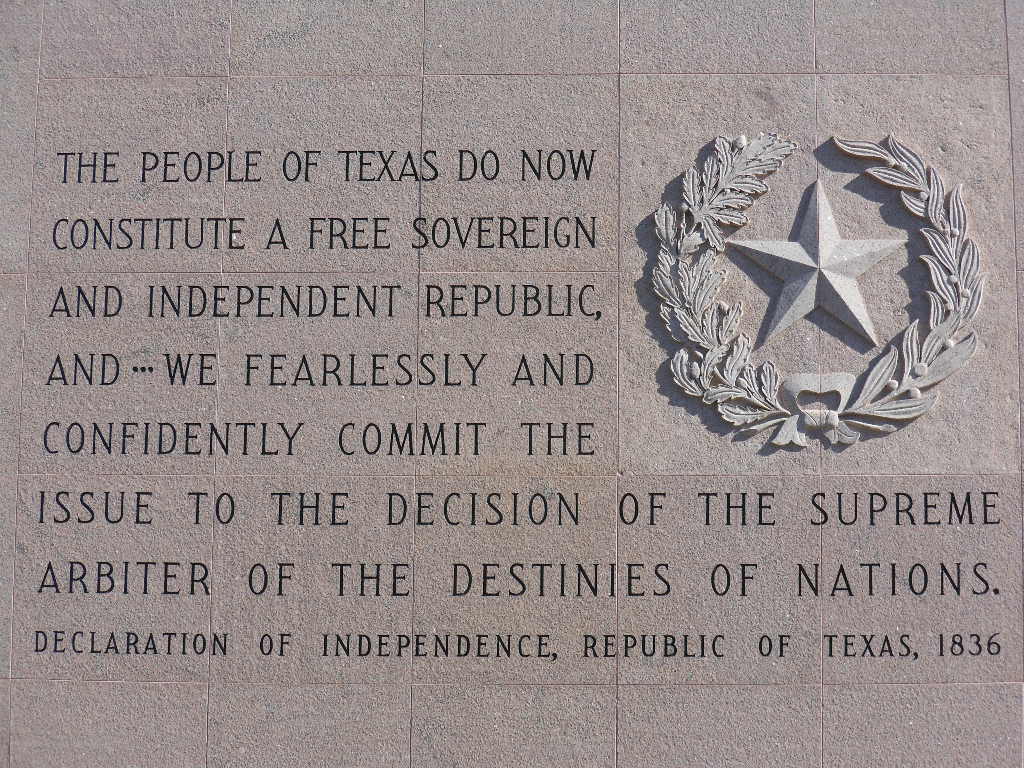
But running a country wasn’t easy. Texas faced a small population, constant threats from Native American tribes, and disputes with Mexico, which still didn’t accept Texas’s independence. Plus, the young republic was deeply in debt and didn’t have the resources to protect itself for long.
Many Texans thought that the best solution was to join the United States.
Texas Joins the United States (Annexation in 1845)
The idea of Texas joining the U.S. wasn’t new. A lot of Texans were originally from America and felt closer to the U.S. than to Mexico. But the U.S. government was hesitant. Why?
- Slavery – Texas allowed slavery, and making it a part of the U.S. would add to the number of slave states, which was a huge issue.
- War with Mexico – Mexico warned that annexing Texas would lead to war, and some American leaders didn’t want to take that risk.
Despite these worries, the political atmosphere changed in the 1840s. Many Americans believed in Manifest Destiny, the idea that the U.S. was meant to expand across North America. Texas fit right into that dream.
In 1845, the U.S. Congress decided to annex Texas, and it officially became the 28th state on December 29, 1845. Texans voted in favor, and the Republic of Texas was no more.
The Mexican-American War (1846–1848)
Just as expected, Mexico was furious about Texas joining the U.S. They claimed Texas was still theirs and rejected the treaties signed by Santa Anna, leading to the Mexican-American War, which started in 1846.
The war lasted two years, and the U.S. eventually defeated Mexico. In 1848, both countries signed the Treaty of Guadalupe Hidalgo. Under this treaty, Mexico recognized Texas as part of the U.S. and gave up a bunch of land in the American Southwest, known as the Mexican Cession. This included parts of modern-day California, Arizona, New Mexico, Nevada, Utah, and Colorado.
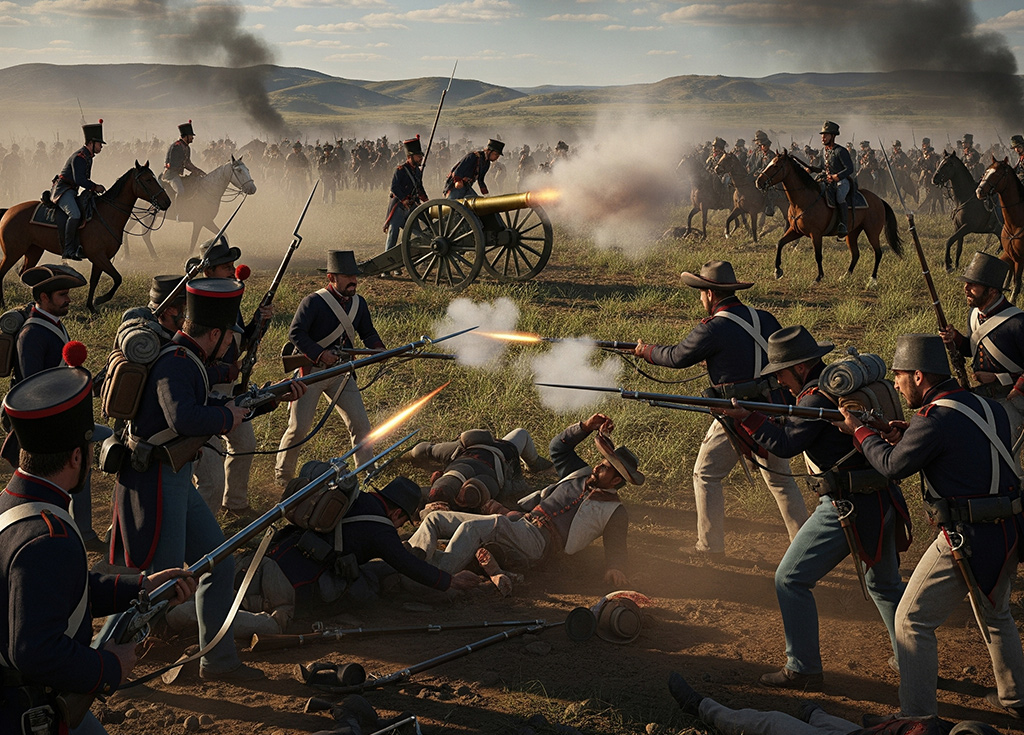
Important People in the Story of Texas Independence
- Stephen F. Austin – Known as the “Father of Texas,” he brought the first major group of American settlers into Texas.
- Sam Houston – The commander of the Texan army and the first president of the Republic of Texas; he was key in winning the war and later joining the U.S.
- Antonio López de Santa Anna – The Mexican general and dictator whose decisions led to the Texas Revolution.
- Davy Crockett – A legendary frontiersman from Tennessee who heroically died at the Alamo.
- William B. Travis – The commander at the Alamo who wrote the famous “Victory or Death” letter.
- James Bowie – Famous for his knife and courage at the Alamo; co-commander of the defenders.
Timeline of Texas Independence and Annexation
1821 – Mexico gains independence from Spain; Texas becomes part of Mexico and welcomes settlers led by Stephen F. Austin.
1829 – Mexico abolishes slavery, angering many American settlers in Texas.
Early 1830s – Santa Anna becomes dictator, ending Texas’s local self-government.
October 2, 1835 – Battle of Gonzales starts the Texas Revolution with the “Come and Take It” flag.
Feb. 23 – Mar. 6, 1836 – Texans lose the Battle of the Alamo but inspire others with “Remember the Alamo!”
March 2, 1836 – Texas declares independence at Washington-on-the-Brazos.
April 21, 1836 – Texans win the Battle of San Jacinto, capturing Santa Anna and securing independence.
1836–1845 – Texas exists as the Republic of Texas but struggles with debt and defense.
Dec. 29, 1845 – Texas joins the United States as the 28th state.
1846–1848 – Mexican-American War ends with Mexico recognizing Texas as U.S. territory.
The Legacy of Texas Independence
The tale of Texas is all about determination, bravery, and a fierce wish for freedom. From a quiet Mexican province to a bold republic, and finally becoming a proud American state, Texas truly carved out its own place in history through passionate battles and strong leadership.
These days, Texans still celebrate Texas Independence Day on March 2, and the cry “Remember the Alamo!” keeps inspiring pride and remembrance for those who fought for liberty. Texas is the only state in the U.S. that once was its own nation, and its bold history is still a big part of its identity.


